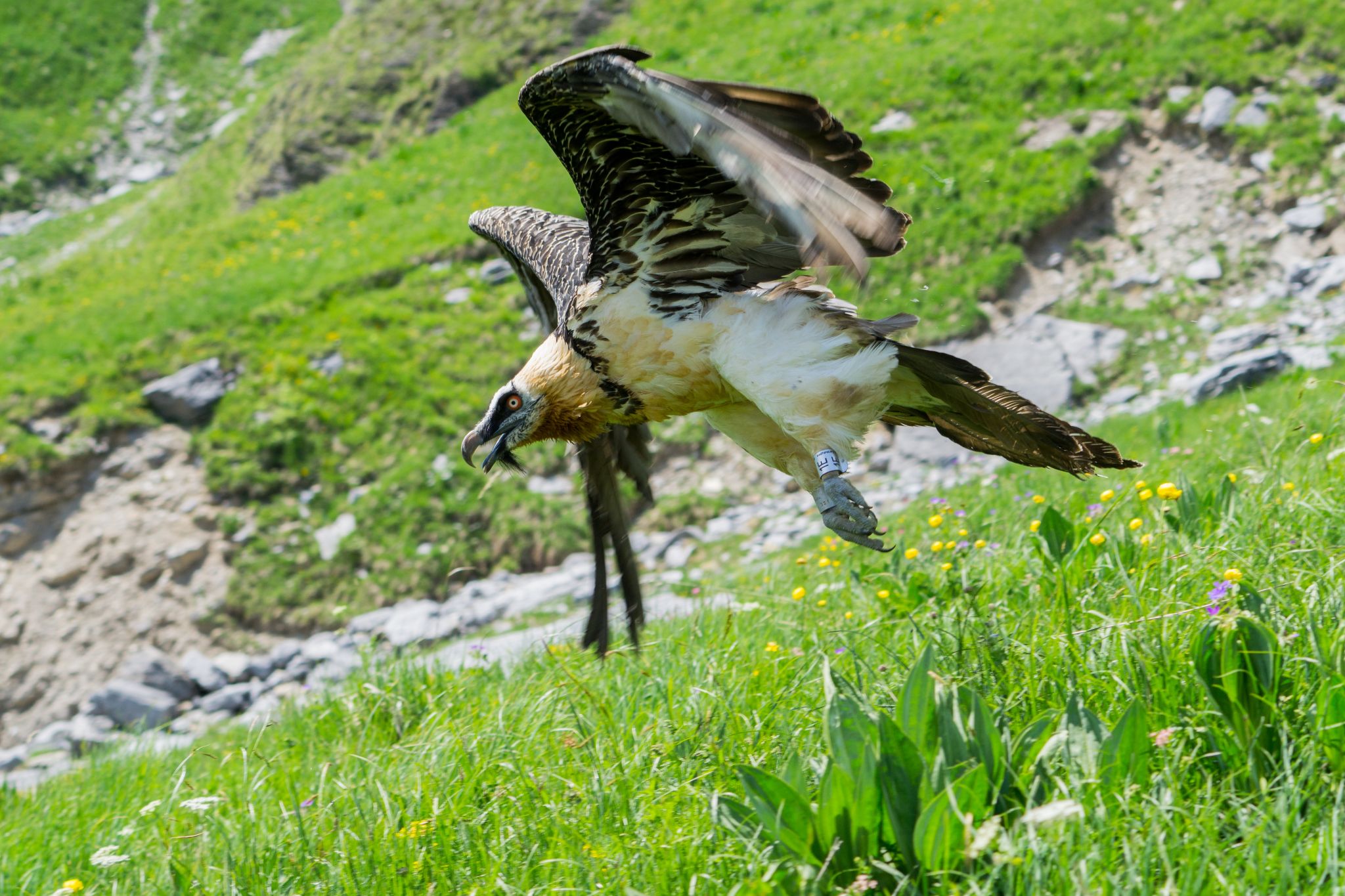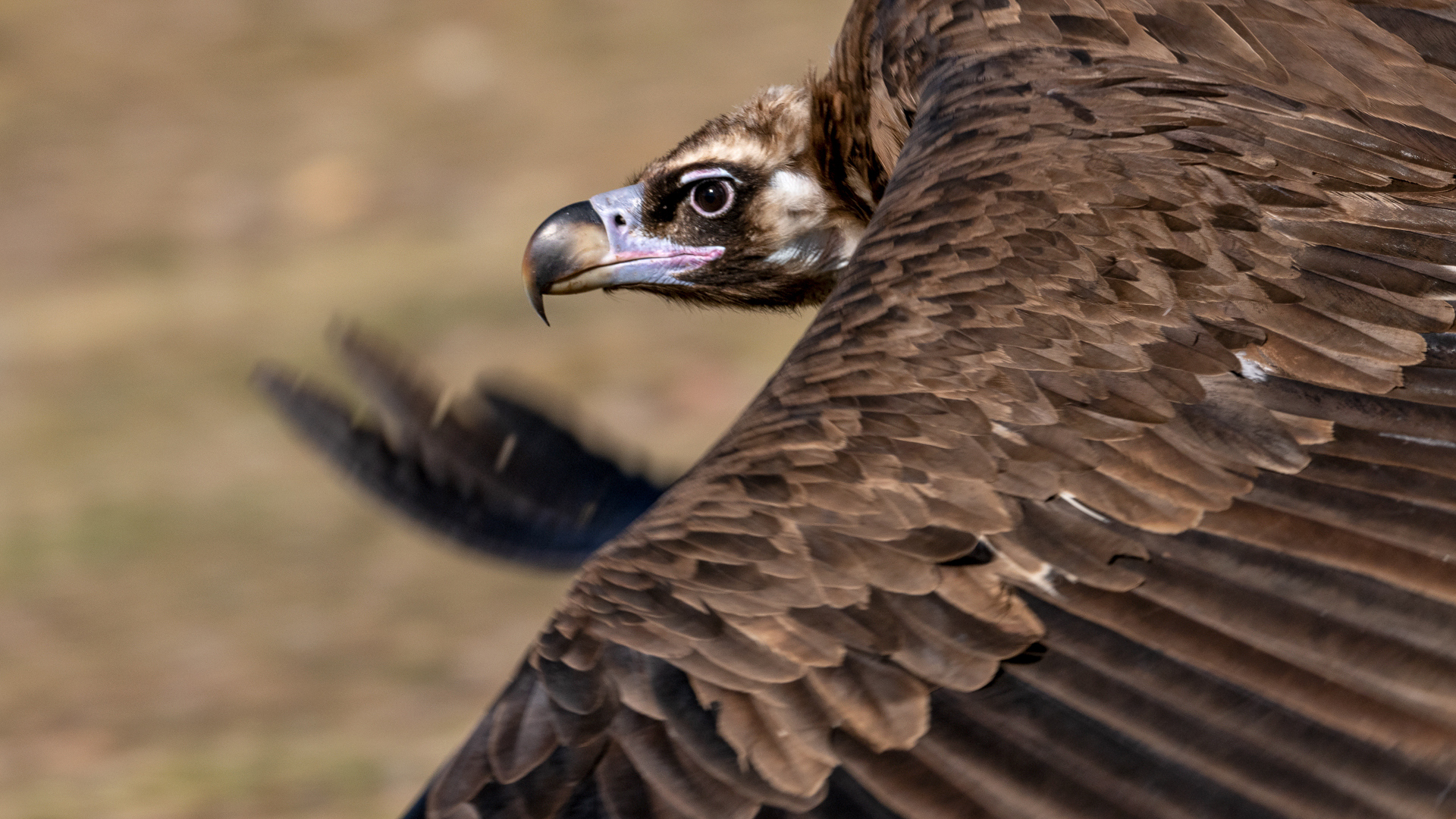The Bearded Vulture Eglazine, whose unusual dispersal habits have caught the attention of many enthusiasts and bird specialists, has moved again! After spending several weeks in Germany during the first winter months, Eglazine headed south, returning to France.

Eglazine is back in France
When in February we shared Eglazine’s position, it was the first time a Bearded Vulture (Gypaetus barbatus) was ever recorded spending the winter months so far north. While dispersal habits are normal in young birds, Eglazine has been surprising us since her very first year in the wild. After spending her first two springs between the Netherlands and Germany, she also seemed willing to spend winter in northwest Europe. Suddenly, however, on 4 February, she started her journey back “home”!

Eglazine becomes an important part of reintroduction efforts
Hatched in captivity in 2020 at Parco Natura Viva (Italy), Eglazine was transferred to a hacking facility in the Grands Causses (France) when she turned three months old, within the LIFE GypConnect project. With the aim of connecting the Alpine and Pyrenean populations through the establishment of a new breeding colony in the Massif Central, Eglazine was one of the 41 Bearded Vultures released between 2015 and 2022. The release of captive-bred individuals into the wild is only possible thanks to the collective efforts of zoos and private breeding centres within the Bearded Vulture Captive Breeding Network members, coordinated by the Vulture Conservation Foundation (VCF) on behalf of EAZA’s Ex situ programme (Bearded Vulture EEP).
Eglazine, the wanderer Bearded Vulture
Through the hacking method, which allows Bearded Vultures to socialise and replicate the species’ natural way of fledging, the region where they fledge gets imprinted as their “home”. The objective is to ensure that reintroduced birds return to that same region once they reach sexual maturity, which normally takes between 6-7 years.
When they are young, Bearded Vultures often endure long distance flights, exploring different habitats while roaming for food. To understand the range of dispersion and act swiftly in case Eglazine needed to be rescued, ahead of her release, the local LPO team fitted her with a GPS transmitter. Since then, we have been following her movements with awe!
In her first nine months in the wild, Eglazine did not disperse much from the Massif Central, but as spring came in 2021, she started moving northwards: flew over Paris downtown, crossed Belgium and stood the summer months strolling between the Hoge Veluwe National Park (Holland) and Germany. On 8 October 2021, Eglazine felt the call to return: in only two days she arrived “home” and wintered in the Grands Causses.
From France to Holland: Eglazine’s own roaming “highway”
When spring 2022 arrived, to our great surprise, Eglazine moved up north again, following roughly the same route she did on the way back. After spending the entire summer in the Netherlands, on 18 October, she started heading south for her autumn return, but as she reached Brussels, she turned back and wandered between the Netherlands and Germany for almost two weeks. Eventually, she made it to Südwestfalen (Germany), where she stood for almost three months, a surprising behaviour for this species, which was never recorded before.
Back then, our main concern was the potential lack of food. Although Bearded Vultures can survive a week or longer without food, the place she chose to stay was very different from the Grands Causses mountain ranges. On 4 February, against all odds and expectations, Eglazine suddenly started heading south and travelled more than 1100 km in 12 days. She reached the Alps, around Chambery (in France), took a detour to cross the Rhone river and moved to the Massif Central. At the Nature Regional Park Volcans d’Auvergne, she found food and cliffs to roost, but she is still 200 km north from her release site. Will she make it to the Grands Causses?
Strengthening the Bearded Vulture population in the Massif Central
The reintroduction of Bearded Vultures in the Massif Central started in 2015, with the LIFE GypConnect project, led by the League pour la Protection des Oiseaux (LPO) and supported by many other partners, including the VCF. During the project, Eglazine and 41 young Bearded Vultures were released in the Pre-Alps and the Massif Central, using the hacking method. As a result, 4 to 5 pairs were formed in the intervention areas and 2022, the final year of the project, a pair successfully bred in the Nature Regional Park Vercors, the first wild fledgling in the region after 150 years.

How the LIFE GypAct project is building on the success of GypConnect
Thanks to a new project, the LIFE GypAct, co-financed by the EU’s LIFE Programme, the conservation efforts will be maintained. The project builds on the encouraging results from GypConnect and includes threat mitigation actions, such as insulating and securing power lines). Project partners will also work with hunters to promote lead-free ammunition, mobilise anti-poison dog units and release another 60 Beaded Vultures in the area, using VCF’s decades of experience in captive breeding and releases in the wild.
Meanwhile, will Eglazine start looking for a place to settle? Or will she continue her wandering adventures and move again to northwest Europe? Subscribe to our newsletter to get the latest updates on Eglazine’s journey!
The LIFE Gyp’Act partnership

LIFE Gyp’Act is a €13M project, co-funded by the EU’s LIFE programme, that will run until 30 November 2028. Project partners are LPO – Ligue pour la Protection des Oiseaux as coordinator beneficiary, and the Vulture Conservation Foundation, Association Vautours en Baronnies, LPO Auvergne-Rhone-Alpes, LPO Occitanie, Sorbonne Université, ENEDIS, Centre National d’Informations Toxicologiques Vétérinaires, Parc National des Cévennes and Parc Naturel Régional du Vercors as associated beneficiaries.




